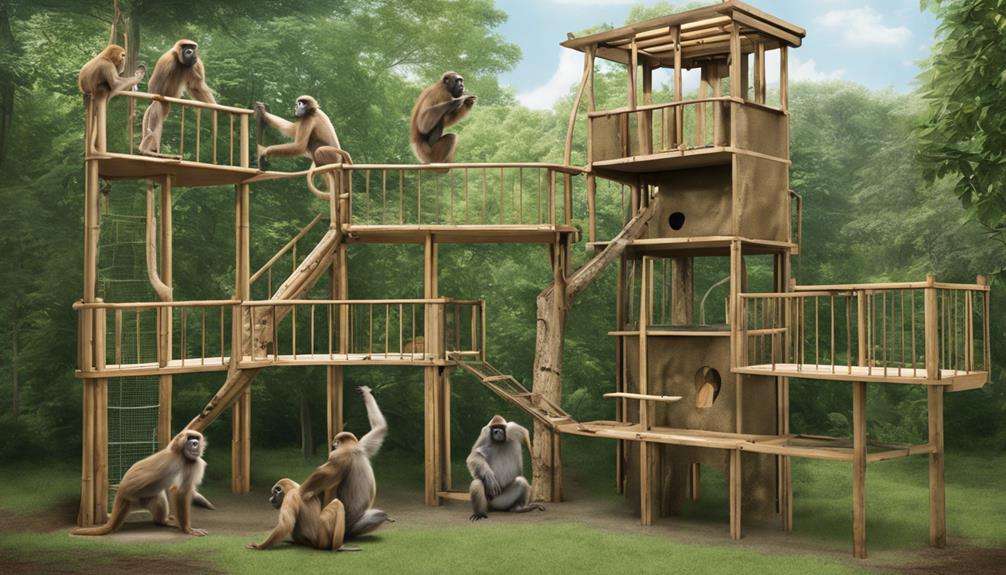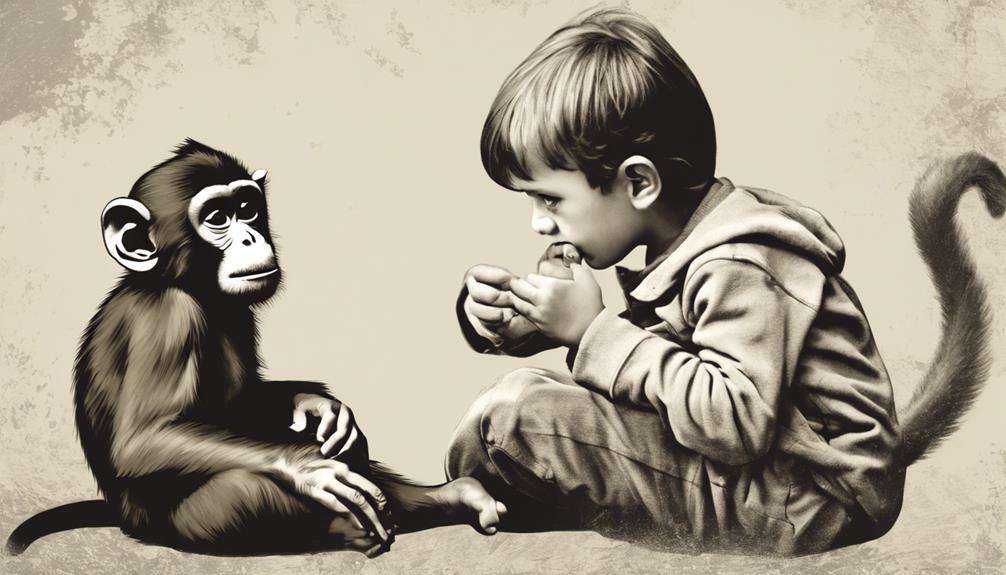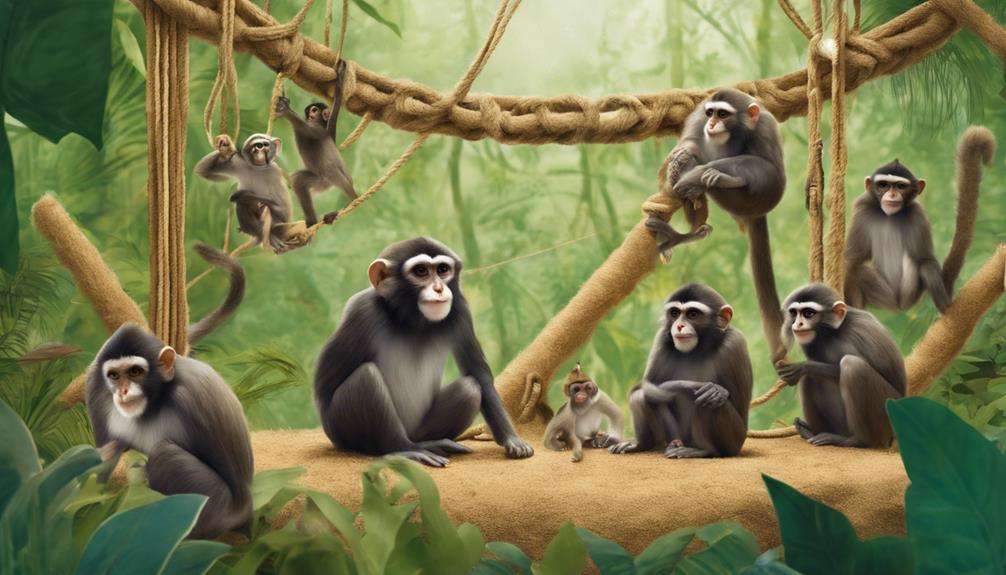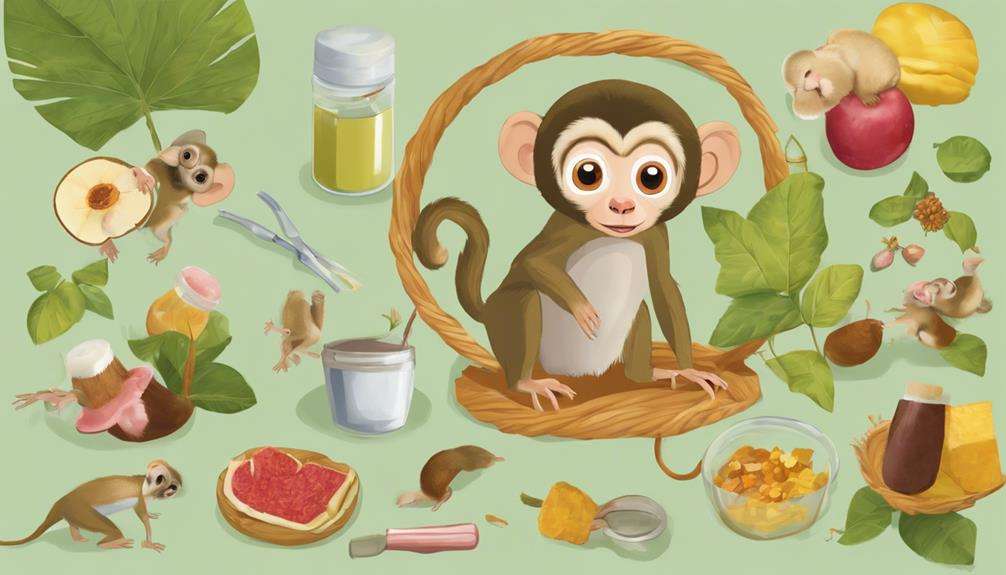When it comes to primate housing requirements, the contrast between their needs and those of other animals is striking. From intricate social structures to complex dietary needs, primates pose a unique challenge in the domain of animal care.
But what makes their housing needs truly exceptional is the intricate balance required to cater to their intelligence, behavioral patterns, and physical strength. As we explore the various facets that contribute to the distinctive nature of primate housing, you'll uncover the intricate web of considerations that make it a fascinating yet demanding field to navigate.
Key Takeaways
- Primate species exhibit diverse social structures and habitat preferences, requiring tailored housing designs.
- Appropriate environmental enrichment and behavioral stimulation are crucial for promoting well-being in primates.
- Cage designs should incorporate structured vertical space, climbing structures, and complex environments to reduce stress.
- Implementing safety protocols, hygiene practices, and health screenings are essential to mitigate disease transmission risks in primate housing.
Primate Species Variability
When observing primate species, their social structures, behaviors, and habitat preferences demonstrate significant variability. Primate species exhibit diverse social structures, ranging from solitary to complex group dynamics. These differences impact their housing requirements, emphasizing the need for tailored designs to meet their species-specific needs for social interaction.
Habitat preferences also vary among primate species, with some favoring arboreal environments while others exhibit terrestrial or mixed locomotion patterns. Understanding these preferences is important for creating enriched environments that promote natural behaviors and support the well-being of the primates.
Tailored housing designs play an important role in meeting the unique characteristics of each primate species, providing opportunities for environmental enrichment and stimulating activities that support their physical and mental health. By recognizing and accommodating the variability in social structure, habitat preferences, and natural behaviors of primate species, housing can be designed to enhance their overall quality of life.
Environmental Enrichment Needs
Primates exhibit increased engagement and well-being when provided with appropriate environmental enrichment.
Stimulating activities like climbing structures and foraging opportunities encourage natural behaviors and mental stimulation.
Social interactions within enriched environments promote positive social bonds and overall welfare in captive primates.
Cage Design
The structured vertical space required for arboreal activities in primate housing necessitates cage designs that incorporate climbing structures like shelves and platforms to promote species-typical behaviors. Monkeys, as social and large primates, thrive in environments that mimic their natural habitat. Research suggests that providing such complex cage spaces can reduce stress and enhance their overall well-being.
These climbing structures not only encourage physical exercise but also mental stimulation, important for the mental and physical health of these animals. By offering elevated platforms and shelves, cages can offer opportunities for exploration, play, and retreat, allowing primates to engage in natural behaviors. The vertical dimension in these cages is essential to make sure that these animals can exhibit their innate behaviors, contributing to their overall welfare.
Behavioral Stimulation
Incorporating various environmental enrichment options is essential to promoting natural behaviors and enhancing the well-being of captive primates. Providing climbing structures, foraging substrate, and opportunities for social interactions are important for their mental and physical health.
Enrichment activities like puzzle feeders and swings mimic behaviors seen in the wild, reducing stereotypic behaviors and aggression. By meeting these environmental enrichment needs, stress levels are lowered, and overall well-being is improved.
Captive primates benefit greatly from a stimulating environment that encourages exploration, problem-solving, and socializing. Enhancing the quality of life through appropriate enrichment options is crucial in creating a habitat that supports the natural behaviors of primates and ensures their mental and physical health.
Behavioral Management Challenges

Handling behavioral management challenges in primate housing requires a vital understanding of how insufficient cage space impacts their well-being. Inadequate cage size restricts their ability to exhibit natural behaviors, leading to stress and maladaptive behaviors. Professional standards emphasize the importance of providing structured space with vertical climbing surfaces to promote arboreal activities and prevent behavioral issues.
Simply increasing cage size may not suffice; the layout should meet behavior-based criteria to make sure the primates' needs are adequately addressed. Without proper environmental enrichment, caged primates may exhibit higher tension levels, develop sporadic disorders, and engage in stereotyped activities.
To maintain the well-being of these animals, it's vital to take into account the impact of cage size and design on their behavior patterns. By adhering to these behavior-focused guidelines, caregivers can create an environment that supports the natural behaviors of primates and minimizes the occurrence of stress-induced behaviors.
Social Group Dynamics
Observing the interaction dynamics within social groups of nonhuman primates reveals intricate hierarchies and the formation of strong bonds among group members. In social housing, captive primates exhibit species-typical behaviors, engaging in grooming, playing, and communicating with one another. These interactions are essential for their social needs and overall well-being.
Hierarchical structures often emerge within these groups, with dominant individuals asserting their authority through gestures, vocalizations, or physical displays. Subordinate members learn to navigate these dynamics, avoiding conflicts and seeking alliances to maintain social harmony. Through these social dynamics, primates establish relationships that provide support, protection, and opportunities for cooperation.
In laboratory settings, understanding and facilitating these natural social interactions are important for promoting the psychological welfare of captive primates. By creating environments that allow for the expression of their social behaviors, researchers can help make sure that these primates lead fulfilling lives in captivity.
Space and Enclosure Design

As you consider the needs of captive primates, the design of their enclosures plays a critical role in ensuring their well-being and satisfaction. For species like macaques, providing adequate cage space goes beyond just meeting legal requirements. It involves creating environments that cater to their natural behaviors, such as incorporating vertical climbing surfaces and perches to facilitate their arboreal tendencies. Studies have shown that simply adhering to basic cage space regulations may not be sufficient without enhancements tailored to the specific behavioral needs of the primates.
When it comes to housing design for primates, focusing on behavior-based criteria is essential. The quality of the cage space, including the presence of structured elements, is crucial for promoting primate well-being. Rather than just looking at the quantity of space available, ensuring that the enclosure is enriched with features that encourage natural behaviors can have a significant impact on the overall satisfaction and health of the primates living within it. By considering these aspects in enclosure design, we can better meet the unique needs of captive primates and enhance their quality of life.
Health and Safety Considerations
Primates in captivity require stringent health and safety measures to mitigate the risks associated with potential disease transmission between humans and these animals. The Animal Welfare Act mandates specific housing requirements for laboratory nonhuman primates, emphasizing unique considerations due to the health risks involved.
Non-human primates are carriers of various diseases like Herpes B virus, Shigella, Salmonella, and tuberculosis, which can pose threats to both human and primate health. Of particular concern are simian viruses that could enter the human blood supply through contact with primates. Moreover, humans can transmit pox viruses, tuberculosis, hepatitis, and meningitis to primates, amplifying the health risks.
Close and frequent interactions between humans and primates elevate the chances of disease transmission for both parties, necessitating strict safety protocols. Ensuring proper hygiene, regular health screenings, and implementing quarantine procedures are crucial in safeguarding the well-being of both humans and captive primates in research facilities and sanctuaries.
Frequently Asked Questions
What Are Some Features That Are Unique to Primates?
You observe primates engaging in unique behaviors. They display remarkable social interactions, manual dexterity, arboreal adaptations, complex communication, parental care, tool use, high cognitive abilities, playful behavior, flexible actions, and hierarchical structures, setting them apart in the animal kingdom.
What Is the Uniqueness of Primates?
In primates, social behavior thrives, as arboreal habitats call. Opposable thumbs grasp tools, aiding in varied diets. Communication complex, eyes forward-facing. Parental care, play behavior, and long lifespans define these unique beings.
Which of the Following Characteristics Are Unique to the Primate Order?
Arboreal adaptations, opposable thumbs, social structures, tool use, complex communication, forward-facing eyes, parental care, long gestation periods, flexible diet, and large brains are unique characteristics of the primate order, reflecting their evolutionary complexity and social behaviors.
What Is Special About Primate Societies?
In primate societies, social dynamics shape interactions, communication methods vary, tool usage is observed, problem-solving skills are evident, parental care is critical, hierarchical structures influence behavior, play is common, nutritional needs vary, cognitive abilities are diverse, and adaptation strategies are employed.
Conclusion
In summary, meeting the unique housing requirements of primates is vital for their well-being. While it may seem challenging to provide the necessary care and environment, it's essential to take into account their specific needs for diet, companionship, and space.
Some may contend that accommodating these requirements is expensive and time-consuming, but the benefits of ensuring the physical and mental health of primates far outweigh any costs or efforts involved. Ultimately, creating a suitable environment for primates is essential for their overall welfare.






